Aluminum Tees
Specializing in the production of aluminum tee pipe fittings, providing a variety of specifications (DN15-DN200), corrosion-resistant, lightweight, suitable for industrial pipelines, HVAC systems and construction projects. Factory direct sales, support customization, 24-hour technical consultation, fast delivery!
Aluminum tee is a pipe fitting shaped like the letter "T", used to connect three sections of pipes at a 90-degree angle. These fittings are made of aluminum, and due to their light weight, corrosion resistance, and durability, they are used in various industries. They help in the transfer or combination of fluid flow in piping, HVAC, and industrial systems.
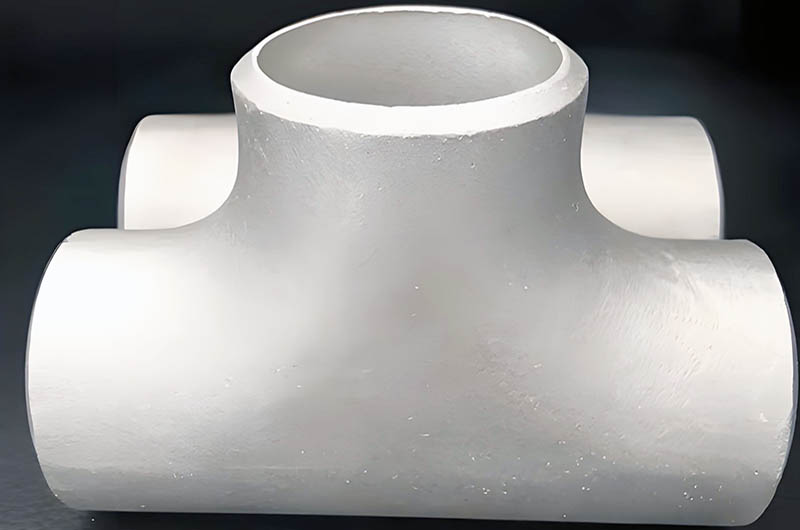
Haomei Aluminum Co., Ltd. specializes in manufacturing aluminum tees and provides aluminum tees in various standard specifications.
| Aluminum tee products (according to application standards) | Aluminum tee specifications |
| Aluminum tee for tank truck AL5083 | 108×5-114×6 |
| Aluminum tee for chemical nitric acid pipeline AL1060 | 18×3-219×10 |
| Aluminum tee for air separation AL5083-5052 | 18×2-1020×30 |
Aluminum tee is a pipe fitting joint made of aluminum alloy, used to connect or split the flow of fluids (liquid or gas) in a pipeline system. The name "tee" comes from its three openings (one inlet and two outlets, or vice versa), allowing the pipeline to extend in three directions, commonly seen in branching, converging, or turning scenarios.
Three ports: typically arranged in a "T" or "Y" shape, with the ports being either equal diameter or reducing diameter.
Aluminum tees can be made by extrusion, machining, or stamping, and are available in different alloys (such as 6061, 6063, 5086, etc.) and temper states (such as T6, T5) to suit various structural, architectural, and industrial applications.
Specification of Haomei Aluminium Tees Products Detial
| Aluminium Pipe Fittings | Form | Seamless and welded |
| Fittings Shape | Elbows, Tees, Reducers, Caps,Nipples | |
| Size Range | 1/2''-24'' | |
| Material | 1000-7000 Series | |
| Wall Thickness | SCH10--SCH160, STD--XXS | |
| Ends Type | Butt weld | |
| Surface treatment | Anodized | |
| Standard | ANSI B16.9, ASTM B361 |
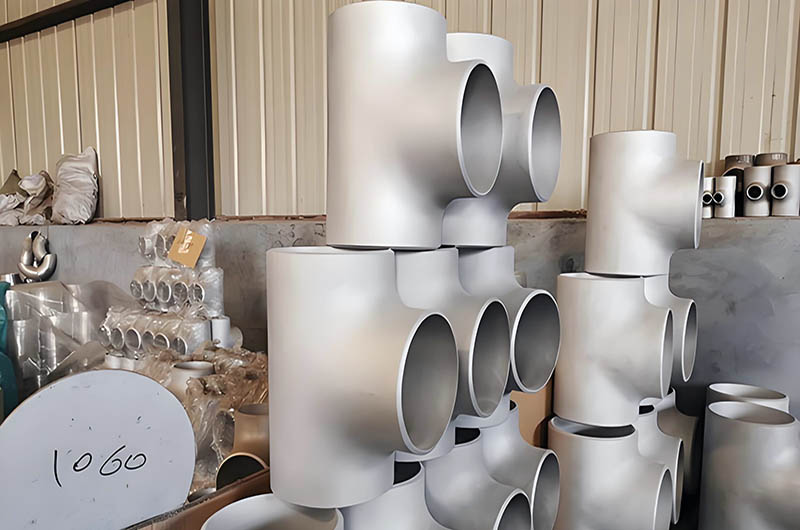
Equal diameter aluminum tee
Types of Aluminum Tee
Structural Classification of Aluminum Tee
Aluminum tees can be classified into three types: straight type, equal diameter elbow type, and reducing type.
- Straight aluminum tee: All the pipe diameters are the same (e.g., DN50×DN50×DN50), mainly used in situations that require splitting or merging.
- Equal diameter elbow aluminum tee: One pipe's diameter differs from the other two, typically used to change the direction of fluid flow.
- Reducing aluminum tee: The main pipe and the branch pipe have different diameters, suitable for situations that require a change in fluid direction with a large flow rate.
Special types:
- Slant tee: The branch ports are angled, reducing fluid resistance.
- Reinforced aluminum tee: Thickened or ribbed at the connection, improving pressure-bearing capacity.
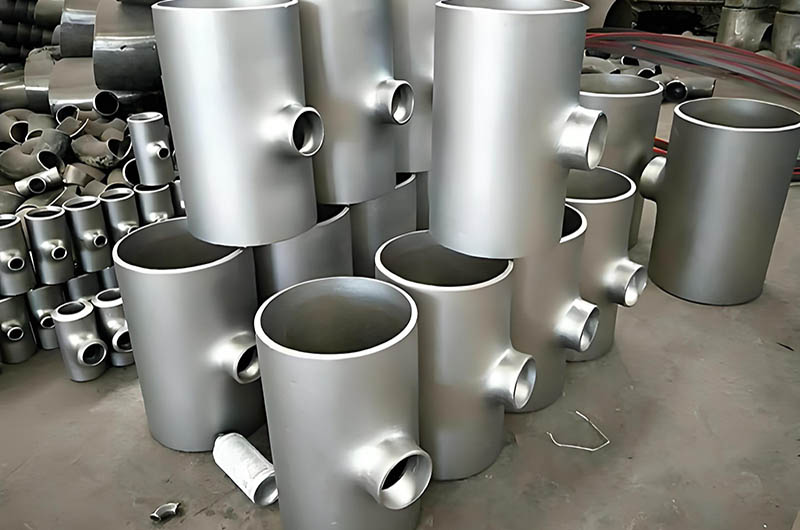
Reducing aluminum tee
Connection Methods of Aluminum Tee
| Aluminum Tee Type | Description |
| Welded Aluminum Tee | The welded aluminum tee is directly welded to the pipe, forming a tight connection with excellent sealing and pressure resistance, effectively preventing leaks. It is suitable for high-pressure liquid or gas transmission systems and is widely used in aviation hydraulic pipelines, industrial networks, and other high-pressure fluid transport scenarios. |
| Threaded Aluminum Tee | The threaded aluminum tee has internal or external threads at the ports, allowing quick connection with corresponding threaded pipe fittings. It is easy to disassemble and maintain, making it suitable for low-pressure fluid transmission systems such as household water supply, industrial equipment pipelines, and laboratory setups. |
| Flanged Aluminum Tee | The flanged aluminum tee is fixed with a flange plate by bolts, forming a firm detachable connection with the pipeline. It can withstand large pipeline pressures and external stresses and is suitable for large-diameter pipeline systems, commonly used in the chemical, shipbuilding, petroleum industries, and large industrial equipment pipelines. |
| Clamp Aluminum Tee | The clamp aluminum tee uses a clamp or ferrule for fastening connection, eliminating the need for welding. It is easy to disassemble and reassemble, making it suitable for low-pressure flexible hose systems that need frequent adjustments or replacements, commonly found in pneumatic equipment, hydraulic systems, food processing pipelines, and laboratory fluid transport systems. |
Processing Methods of Aluminum Tee
| Aluminum Tee Processing Method | Description |
| Stamped Aluminum Tee | The stamped aluminum tee uses stamping technology to form it once or multiple times with a mold, especially suitable for manufacturing reducing products. This process makes the surface of the aluminum tee smooth, reducing subsequent processing steps and improving the product's consistency and appearance. Additionally, due to the high degree of automation, stamped aluminum tees are highly efficient and suitable for mass production, widely used in systems that require standardized pipe connections and low fluid resistance, such as ventilation ducts, air conditioning pipelines, and general industrial fluid transportation. |
| Seamless Welded Aluminum Tee | The seamless welded aluminum tee uses precise welding technology to weld different parts together seamlessly, ensuring the product's sealing and strength in high-pressure or high-precision applications. This process effectively avoids weld defects, enhancing pressure resistance and corrosion resistance, making it suitable for industries with high requirements, such as aerospace, petrochemicals, hydraulic pipeline systems, and high-pressure gas transmission fields. The high strength of seamless welded aluminum tees ensures reliable performance even in extreme environments. |
| Cast Aluminum Tee | Sand casting or die-casting processes, suitable for complex structures or high-strength applications (e.g., high-pressure valves). |
Classification of Aluminum Tee by Usage
- Standard Type: Regular wall thickness (1-5mm), used in low-pressure environments (e.g., building ventilation).
- Reinforced Type: Increased wall thickness (5-10mm) or added reinforcing ribs, suitable for high-pressure or vibration scenarios (e.g., petrochemical pipelines).
Application Scenarios of Different Types of Aluminum Tees
| Type | Application Field | Specific Use |
| Equal Diameter Aluminum Tee | Air Conditioning Systems | Even distribution of refrigerant |
| Water Treatment Pipes | Diverting filtration or backwash processes | |
| Reducing Aluminum Tee | Chemical Pipelines | Branching to inject chemicals (e.g., DN100 main pipe connects to DN50 branch pipe) |
| Petroleum Transport | Adjusting branch flow to balance pressure | |
| Extruded Aluminum Tee | Building Drainage | Standardized fire protection pipeline systems |
| Solar Panel Brackets | Lightweight structural connections | |
| Cast Aluminum Tee | Ship Pipelines | Complex interfaces resistant to seawater corrosion |
| Hydraulic Systems | Diverting high-pressure oil lines (e.g., construction machinery) | |
| Reinforced Aluminum Tee | Power Plant Steam Pipelines | Resistant to high temperature and pressure (PN25 and above) |
| Natural Gas Transport | Seismic and impact resistance design |
How to Choose the Right Aluminum Tee Specifications Based on Requirements?
| Selection Factors | Specific Requirements | Applicable Scenarios |
| Clarify Operational Requirements | Medium Characteristics | Corrosive liquids (such as acids and alkalis) require corrosion-resistant materials (6063 + anodizing) |
| Pressure/Temperature | High-temperature steam (>150℃) requires thick-walled (≥5mm) + 6061-T6 material | |
| Flow Requirements | Large flow (e.g., DN200 or above) should prioritize welding or casting processes | |
| Match Connection Type | Threaded Connection | Small diameter (DN≤50), low pressure (PN6-PN10) scenarios, such as household water supply |
| Flanged Connection | Industrial pipelines that require frequent disassembly (e.g., chemical plant reactors) | |
| Butt Weld Connection | High-pressure seamless pipelines (e.g., PN40 natural gas mainline) | |
| Consider Environmental Factors | Outdoor Exposure | Choose surface anodizing or spraying treatment (e.g., fluorocarbon spraying for coastal areas) |
| Space Limitations | In compact areas, choose short-end tees (e.g., in server room pipelines) | |
| Cost and Standards | Limited Budget | Extruded standard parts (30%-50% cheaper) |
| Industry Certification | Food industry needs to comply with FDA standards (e.g., 3003 aluminum alloy) |
Aluminum Tee Material Options and Characteristics
Aluminum Tee Materials
Aluminum tees are typically made from alloys such as 6061, 6063, or 7075.
- 6061 alloy has excellent weldability, machinability, and high strength, making it suitable for structural applications.
- 6063 alloy is often used in architectural decoration and extrusion profiles due to its fine surface finish and consistency when anodized or painted.
Aluminum Tee Advantages
The inherent advantages of aluminum—light weight, high strength, and good corrosion resistance—make these tees ideal for a variety of applications.
Aluminum tees combine versatility with excellent mechanical and chemical properties, making them a popular choice in industries ranging from construction and architecture to aerospace and marine engineering. Their customizable features (in alloys, toughness, sizes, and surface treatments) ensure they can be tailored to meet the specific needs of any project.
- Lightweight: With a density only 1/3 that of steel, suitable for weight reduction needs in aviation, automotive, etc.
- Corrosion resistance: The natural oxide film on aluminum resists corrosion from the atmosphere, water, and some chemical media.
- Good thermal and electrical conductivity: Suitable for applications like radiators, cooling systems, etc.
- Easy to process: High plasticity, easy to cut, weld, and bend.
- Lightweight: Easier to handle and install compared to steel or iron fittings.
- Ductility: Allows precise manufacturing and adaptation to various configurations.
- Recyclability: Environmentally friendly, as aluminum is 100% recyclable.
Aluminum Tee Disadvantages
- Lower strength: Pressure capacity is lower than stainless steel, and it softens at high temperatures.
- Higher cost: Compared to plastic fittings like PVC, aluminum is more expensive.
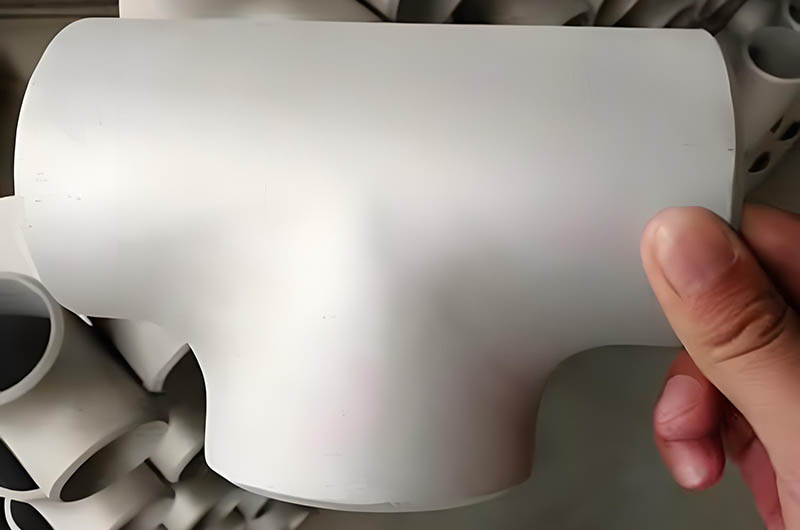
Common sizes of Haomei aluminum tees
| NPS | Insulation thickness | ||||||
| 1" | 1 1/2" | 2" | 2 1/2" | 3" | 3 1/2" | 4" | |
| 1/2" | #1 | #3 | #5 | #7 | #8 | #9 | #10 |
| 3/4" | #1 | #3 | #5 | #7 | #8 | #9 | #10 |
| 1" | #2 | #4 | #6 | #7 | #8 | #9 | #10 |
| 1 1/4" | #2 | #5 | #6 | #7 | #8 | #9 | #10 |
| 1 1/2" | #3 | #5 | #7 | #8 | #9 | #10 | #11 |
| 2" | #4 | #6 | #7 | #8 | #9 | #10 | #11 |
| 2 1/2" | #5 | #7 | #8 | #9 | #10 | #11 | #12 |
| 3" | #6 | #7 | #8 | #9 | #10 | #11 | #12 |
| 4" | #7 | #8 | #9 | #10 | #11 | #12 | #13 |
| 6" | #9 | #10 | #11 | #12 | #13 | #14 | #15 |
| 8" | #11 | #12 | #13 | #14 | #15 | #16 | #17 |
| 10" | #13 | #14 | #15 | #16 | #17 | #18 | #19 |
| 12" | #15 | #16 | #17 | #18 | #19 | #20 | #21 |
| 14" | #16 | #17 | #18 | #19 | #20 | #21 | #22 |
| 16" | #18 | #19 | #20 | #21 | #22 | #23 | #24 |
| 18" | #20 | #21 | #22 | #23 | #24 | ||
| 20" | #22 | #23 | #24 | ||||
Aluminum Tee Manufacturing Process
They are typically produced by extrusion, which creates long, uniform profiles that can be cut to the desired size. Machining and pressing are also used to achieve precise dimensions and surface finishes. These processes ensure that tees meet industry standards (such as ASTM, AMS) for dimensional accuracy and performance.
Processing Methods for Aluminum Alloy Tees
- Casting/Extrusion: Tees are typically formed by casting or extrusion methods and then machined to achieve precise threads (NPT, BSP) or smooth ends for welding.
- Welding/Connection: Some tees use welding (butt weld, socket weld) or are designed with push-fit connection ends for quick assembly.
| Forming Method | Process Description | Advantages | Disadvantages |
| Extrusion Forming | Aluminum billets are heated and extruded through a die to form the tee blank, then the ends are machined. | Suitable for mass production, cost-effective. | Restricted by die design, limited complexity of structures. |
| Casting | Molten aluminum is poured into a mold to form the tee. | Can produce complex shapes. | Tends to produce porosity, requires subsequent treatment. |
| Welding Forming | Aluminum tubes are cut and welded into a tee shape. | Highly flexible, suitable for custom sizes. | Lower production efficiency, welding quality affected by process. |
- Mainstream Processes: Hydraulic bulging and hot pressing forming, suitable for seamless pipe processing.
- Special Processes: Stamping and angled seamless welding technology, suitable for large diameter or irregular structures.
Heat Treatment and Surface Treatment Processes for Aluminum Tees
Surface Treatment: Anodizing or powder coating can enhance corrosion resistance and aesthetics; coatings can also be used for specific chemical resistance.
- Anodizing: Increases surface hardness and corrosion resistance, with optional colors.
- Sandblasting/Powder Coating: Improves appearance, suitable for different environmental needs.
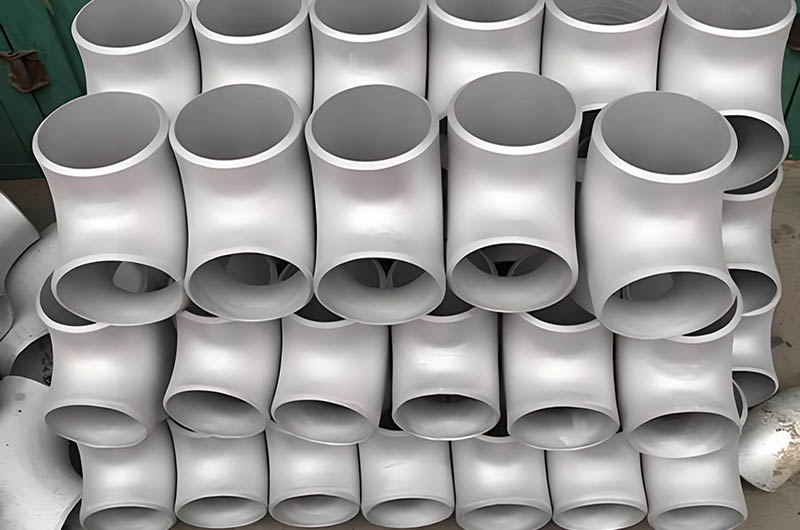
Aluminum Tees Applications
Aluminum tees are widely used in various engineering and industrial applications due to their lightweight, corrosion resistance, and cost-effectiveness.
Which industries use aluminum tees?
- Marine and outdoor applications: Resistant to saltwater corrosion.
- Plumbing systems: Used to branch or merge water pipes.
- Refrigeration and air conditioning systems: Used for distributing refrigerants or changing flow direction.
- Automotive manufacturing: Used in engine cooling systems, fuel systems, etc.
- Building drainage systems: Used to collect multiple drainage branches into a main drain.
Application of Aluminum Tees in Building Water Supply and Drainage Systems
Aluminum tees are primarily used in the diversion and collection of hot and cold water pipelines in building water supply and drainage systems. They are particularly favored in high-rise buildings and underground pipe networks due to their lightweight, corrosion resistance, and easy installation.
Aluminum tees made from 6063 aluminum alloy and extruded, followed by anodizing treatment, can effectively resist corrosion from chlorides in water and provide a longer service life. Additionally, flanged or butt-welded reinforced aluminum tees are suitable for high-pressure water supply systems, ensuring pipeline stability, reducing leakage risks, and improving system safety and reliability.
Use of Aluminum Tees in Air Conditioning and Refrigeration Systems
Aluminum tees are mainly used for the even distribution of refrigerants and pipe connections in air conditioning and refrigeration systems. They are widely applied in central air conditioning, industrial cooling systems, and cold chain logistics equipment.
Aluminum tees made from 6061-T6 aluminum alloy provide excellent pressure resistance and thermal conductivity, effectively reducing refrigerant flow resistance and improving heat exchange efficiency. For large refrigerant flow, welded or cast aluminum tees are more suitable for high-load systems, as they can reduce stress concentration at connection points while ensuring sealing, extending the entire system's lifespan.
Other Potential Application Areas
- Industrial pipelines: Water supply, chemical processing, and natural gas pipelines (where compatible).
- HVAC systems: Air ducts, refrigerant pipelines, air conditioning branch ducts, and refrigerant pipelines.
- Structural frameworks: Connections and branching in building construction, automotive and truck frames, and other load-bearing systems.
- Piping systems and insulation: As fittings in piping systems or caps in insulated pipe joints (tee caps).
- Architectural and decorative applications: Applications requiring clean, modern aesthetics (e.g., architectural decoration, displays, and framing systems).
- Chemical equipment: Used for handling highly corrosive acidic or alkaline medium transport.
Comparison with Tees Made from Other Materials
| Characteristics | Aluminum Tee | Stainless Steel Tee | PVC Tee |
| Weight | Light | Heavy | Extremely Light |
| Strength | Medium | High | Low |
| Corrosion Resistance | Good (except strong acids and bases) | Excellent | Excellent (resistant to chemical corrosion) |
| Cost | Medium | High | Low |
| Temperature Range | -20℃ to 150℃ | -200℃ to 800℃ | 0℃ to 60℃ |
Selection and Installation of Aluminum Tees
What factors should be considered when selecting?
Selection parameters:
- Pressure Rating: Choose the wall thickness based on the system's operating pressure (e.g., Sch40, Sch80).
- Fluid Compatibility: Ensure that the aluminum material can withstand the chemical properties of the fluid (avoid strong acids and bases).
- Temperature Range: Regular aluminum tees are suitable for -20℃ to 150℃, special alloys are required for high temperatures.
- Ensure size specifications match the pipeline.
- Choose material and wall thickness.
What should be noted during installation?
Installation considerations:
- Sealing: Use PTFE tape or sealing glue for threaded connections; welding should prevent oxidation (TIG welding).
- Support and Fixation: For long pipelines, add supports at branch points to avoid vibration-induced fatigue fractures.
- Avoid Galvanic Corrosion: Prevent direct contact with dissimilar metals like copper and steel; use insulating gaskets when necessary.
Maintenance and Troubleshooting
- Regular Inspection: Check for leaks at the joints and any oxidation white spots (signs of corrosion).
- Cleaning Method: Use neutral cleaners; avoid strong acids or alkaline cleaning agents.
Common Issues:
- Leaks: Replace seals or re-weld.
- Clogging: Disassemble and remove internal deposits (e.g., scale).

